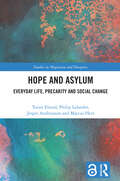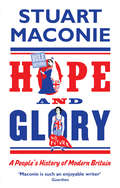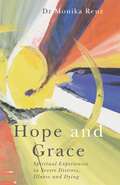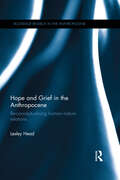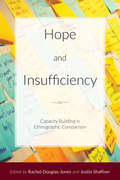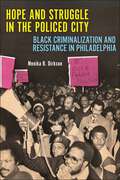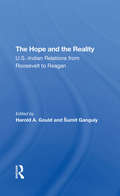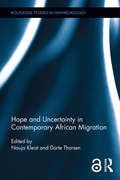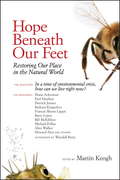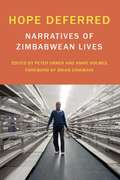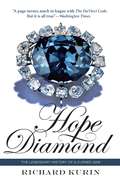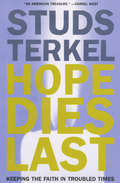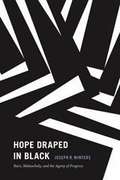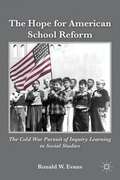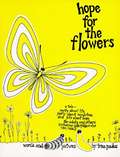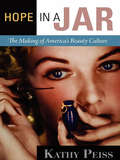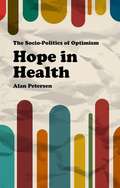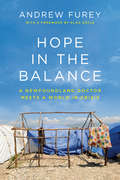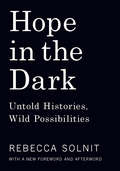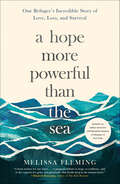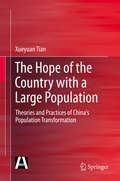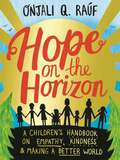- Table View
- List View
Hope and Asylum: Everyday Life, Precarity and Social Change (Studies in Migration and Diaspora)
by Jesper Andreasson Marcus Herz Philip Lalander Torun ElsrudThis book applies perspectives of hope to understand the precariousness, suffering, and agency of people seeking asylum. With attention to the restrictions and austerity politics that have characterised public policy following the significant rise in asylum applications in 2015, it draws on longitudinal ethnographic fieldwork in the Swedish asylum context, together with data collected in other European countries, to explore how the circumstances of those navigating asylum processes evolve and connect to their notions of hope and the future. Departing from the ambiguities and fragility surrounding hope in the asylum context, Hope and Asylum analyses people’s lived experiences and their navigation of uncertainty and precariousness during the migration process. While hope can provide individuals with support and empowerment, it can also cause pain and be exploited by authorities to control and disempower. The book argues that critically scrutinising current asylum regimes and exposing the enduring emotional and embodied scars they inflict through the bureaucratic violence of welfare states is essential for mobilising efforts toward social justice and human rights. Demonstrating the importance of hope and related concepts to our understanding of daily life experiences, social interaction, and precariousness within the asylum context, it will appeal to scholars across the social sciences with interests in migration and diaspora, immigration policy, refugee studies, and asylum regimes.Book: The Open Access version of this book, available at http://www.taylorfrancis.com, has been made available under a Creative Commons [Attribution-Non Commercial-No Derivatives (CC-BY-NC-ND)] 4.0 license.
Hope and Glory: A People’s History of Modern Britain
by Stuart MaconieIn Hope and Glory Stuart Maconie goes in search of the days that shaped the Britain we live in today. Taking one event from each decade of the 20th century, he visits the places where history happened and still echoes down the years. Stuart goes to Orgreave and Windsor, Wembley and Wootton Bassett, assembling a unique cast of Britons from Sir Edmund Hillary to Sid Vicious along the way.It’s quite a trip, full of sex and violence and the occasional scone and jigsaw. From pop stars to politicians, Suffragettes to punks, this is a journey around Britain in search of who we are.
Hope and Grace: Spiritual Experiences in Severe Distress, Illness and Dying
by Monika Renz Mark KyburzConventional coping strategies can be pushed to their limits when people find themselves in situations of suffering, illness, and dying. Moved beyond their everyday consciousness, individuals often have spiritual experiences of grace and encounters with the transcendent or the divine. The author shows how care providers can support patients in their suffering and how they can recognize patients' spiritual experiences. Explaining different types of experiences of transcendence such as seeing angels or feelings of otherness and presence, this book will be of valuable use to professionals working in palliative and spiritual care, such as spiritual caregivers, therapists, nurses, and physicians. The book entails a new approach to spiritual care which opens a space of hope wherein grace may happen even amid pain, suffering, illness and dying.
Hope and Grief in the Anthropocene: Re-conceptualising human–nature relations (Routledge Research in the Anthropocene)
by Lesley HeadThe Anthropocene is a volatile and potentially catastrophic age demanding new ways of thinking about relations between humans and the nonhuman world. This book explores how responses to environmental challenges are hampered by a grief for a pristine and certain past, rather than considering the scale of the necessary socioeconomic change for a 'future' world. Conceptualisations of human-nature relations must recognise both human power and its embeddedness within material relations. Hope is a risky and complex process of possibility that carries painful emotions; it is something to be practised rather than felt. As centralised governmental solutions regarding climate change appear insufficient, intellectual and practical resources can be derived from everyday understandings and practices. Empirical examples from rural and urban contexts and with diverse research participants - indigenous communities, climate scientists, weed managers, suburban householders - help us to consider capacity, vulnerability and hope in new ways.
Hope and Insufficiency: Capacity Building in Ethnographic Comparison
by Rachel Douglas-Jones Justin ShaffnerA process through which skills, knowledge, and resources are expanded, capacity building, remains a tantalizing and pervasive concept throughout the field of anthropology, though it has received little in the way of critical analysis. By exploring the concept’s role in a variety of different settings including government lexicons, religious organizations, environmental campaigns, biomedical training, and fieldwork from around the globe, Hope and Insufficiency seeks to question the histories, assumptions, intentions, and enactments that have led to the ubiquity of capacity building, thereby developing a much-needed critical purchase on its persuasive power.
Hope and Struggle in the Policed City: Black Criminalization and Resistance in Philadelphia
by Menika B. DirksonExplores how concerns about poverty-induced Black crime cultivated by police, journalists, and city officials sparked a rise in tough-on-crime policing in PhiladelphiaDuring the Great Migration of African Americans to the North, Philadelphia’s police department, journalists, and city officials used news media to create and reinforce narratives that criminalized Black people and led to police brutality, segregation, and other dehumanizing consequences for Black communities. Over time, city officials developed a system of racial capitalism in which City Council financially divested from social welfare programs and instead invested in the police department, promoting a “tough on crime” policing program that generated wealth for Philadelphia’s tax base in an attempt to halt white flight from the city.Drawing from newspapers, census records, oral histories, interviews, police investigation reports, housing project pamphlets, maps, and more, Hope and Struggle in the Policed City draws the connective line between the racial bias African Americans faced as they sought opportunity in the North and the over-policing of their communities, of which the effects are still visible today. Menika B. Dirkson posits that the tough-on-crime framework of this time embedded itself within every aspect of society, leading to enduring systemic issues of hyper-surveillance, the use of excessive force, and mass incarceration.Hope and Struggle in the Policed City makes important contributions to our understanding of how a city government’s budgetary strategy can function as racial capitalism that relies on criminal scapegoating. Most cogently, it illustrates how this perpetuates the cycle of poverty-induced crime, inflates rates of incarceration and police brutality, and marginalizes poor people of color.
The Hope And The Reality: U.s.-indian Relations From Roosevelt To Reagan
by Harold A Gould Sumit GangulyThis book charts the relationship between the evolving governments of independent India and concurrent US presidential administrations. It provides an in-depth analysis of the motivations, external constraints and ideological agendas that characterized Indian-US relations.
Hope and Uncertainty in Contemporary African Migration (Routledge Studies in Anthropology)
by Nauja Kleist Dorte ThorsenThis volume examines the relationship between hope, mobility, and immobility in African migration. Through case studies set within and beyond the continent, it demonstrates that hope offers a unique prism for analyzing the social imaginaries and aspirations which underpin migration in situations of uncertainty, deepening inequality, and delimited access to global circuits of legal mobility. The volume takes departure in a mobility paradox that characterizes contemporary migration. Whereas people all over the world are exposed to widening sets of meaning of the good life elsewhere, an increasing number of people in the Global South have little or no access to authorized modes of international migration. This book examines how African migrants respond to this situation. Focusing on hope, it explores migrants’ temporal and spatial horizons of expectation and possibility and how these horizons link to mobility practices. Such analysis is pertinent as precarious life conditions and increasingly restrictive regimes of mobility characterize the lives of many Africans, while migration continues to constitute important livelihood strategies and to be seen as pathways of improvement. Whereas involuntary immobility is one consequence, another is the emergence and consolidation of new destinations emerging in the Global South. The volume examines this development through empirically grounded and theoretically rich case studies in migrants’ countries of origin, zones of transit, and in new and established destinations in Europe, North America, the Middle East, Latin America and China. It thereby offers an original perspective on linkages between migration, hope, and immobility, ranging from migration aspirations to return.
Hope Beneath Our Feet: Restoring Our Place in the Natural World
by Barbara Kingsolver Howard Zinn Alice Walker Martin Keogh Michael PollanThe environmental "tipping point" we approach is more palpable each day, and people are seeing it in ways they can no longer ignore--we need only turn on the news to hear the litany of what is wrong around us. Serious reflection, inspiration, and direction on how to approach the future are now critical. Hope Beneath Our Feet creates a space for change with stories, meditations, and essays that address the question, "If our world is facing an imminent environmental catastrophe, how do I live my life right now?" This collection provides tools, both practical and spiritual, to those who care about our world and to those who are just now realizing they need to care. Featuring prominent environmentalists, artists, CEOs, grassroots activists, religious figures, scientists, policy makers, and indigenous leaders, Hope Beneath Our Feet shows readers how to find constructive ways to channel their energies and fight despair with engagement and participation. Presenting diverse strategies for change as well as grounds for hope, the contributors to this anthology celebrate the ways in which we can all engage in beneficial action for ourselves, our communities, and the world.Contributors include: Diane Ackerman, Paul Hawken, Derrick Jensen, Barbara Kingsolver, Francis Moore Lappé, Barry Lopez, Bill McKibben, Michael Pollan, Alice Walker, Howard Zinn.
Hope Deferred
by Annie Holmes Peter OrnerThe situation in Zimbabwe represents one of the worst humanitarian emergencies today. This book asks the question: How did a country with so much promise - a stellar education system, a growing middle class, a sophisticated economic infrastructure, a liberal constitution, an independent judiciary, and many of the trappings of Western democracy - go so wrong? In their own words, Zimbabweans recount their experiences of losing their homes, land, livelihoods, and families as a direct result of political violence. They describe being tortured in detention, firebombed at work, or beaten up or raped to "punish" votes for the opposition. Those forced to flee to neighboring countries recount their escapes: cutting through fences, swimming across crocodile-infested rivers, and entrusting themselves to human smugglers. This book includes Zimbabweans of every age, class, and political conviction, from farm laborers to academics, doctors to artists, opposition leaders to ordinary Zimbabweans; men and women simply trying to survive as a once-thriving nation heads for collapse.
Hope Diamond: The Legendary History of a Cursed Gem
by David J. Skorton Richard KurinThe true story behind the most famous-and infamous-stone in the world. The Hope diamond is not only exceptionally beautiful it has a long and incredibly colorful history. That history - spread over three continents - features diamond mining in India, the French Revolution, the machinations of British King George IV, the Gilded Age in America and a number of very clever jewelers including Pierre Cartier and Harry Winston. In the 20th century, the myth of the Hope diamond curse made the diamond more notorious and famous than ever before, but it is only one small piece of a long and lustrous history. Dr. Kurin, who is a cultural anthropologist, has spent over a decade on the trail of the Hope, from India, to France, Germany, Russia, Switzerland, and England. His narrative is filled with fascinating places and people - from the fabled diamond city of Golconda to the fabulously rich heiress Evalyn McLean to Jackie Kennedy and her pivotal role in one of the Hopes few 20th century trips abroad.
Hope Dies Last: Keeping the Faith In Troubled Times
by Studs TerkelAmerica&’s most inspirational voices, in their own words: &“If you&’re looking for a reason to act and dream again, you&’ll find it in the pages of this book&” (Chicago Tribune). Published when Studs Terkel was ninety-one years old, this astonishing oral history tackles one of the famed journalist&’s most elusive subjects: Hope. Where does it come from? What are its essential qualities? How do we sustain it in the darkest of times? An alternative, more personal chronicle of the &“American century,&” Hope Dies Last is a testament to the indefatigable spirit that Studs has always embodied, and an inheritance for those who, by taking a stand, are making concrete the dreams of today. A former death row inmate who served nearly twenty years for a crime he did not commit discusses his never-ending fight for justice. Tom Hayden, author of The Port Huron Statement, contemplates the legacy of 1960s student activism. Liberal economist John Kenneth Galbraith reflects on the enduring problem of corporate malfeasance. From a doctor who teaches his young students compassion to the retired brigadier general who flew the Enola Gay over Hiroshima, these interviews tell us much about the power of the American dream and the force of individuals who advocate for a better world. With grace and warmth, Terkel&’s subjects express their secret hopes and dreams. Taken together, this collection of interviews tells an inspiring story of optimism and persistence, told in voices that resonate with the eloquence of conviction. &“The value of Hope Dies Last lies not in what it teaches readers about its narrow subject, but in the fascinating stories it reveals, and the insight it allows into the vast range of human experience.&” —The A.V. Club &“Very Terkelesque—by now the man requires an adjective of his own.&” —Margaret Atwood, The New York Times Review of Books &“An American treasure.&” —Cornel West
Hope Draped in Black: Race, Melancholy, and the Agony of Progress
by Joseph R. WintersIn Hope Draped in Black Joseph R. Winters responds to the enduring belief that America follows a constant trajectory of racial progress. Such notions--like those that suggested the passage into a postracial era following Barack Obama's election--gloss over the history of racial violence and oppression to create an imaginary and self-congratulatory world where painful memories are conveniently forgotten. In place of these narratives, Winters advocates for an idea of hope that is predicated on a continuous engagement with loss and melancholy. Signaling a heightened sensitivity to the suffering of others, melancholy disconcerts us and allows us to cut against dominant narratives and identities. Winters identifies a black literary and aesthetic tradition in the work of intellectuals, writers, and artists such as W. E. B. Du Bois, Ralph Ellison, Toni Morrison, and Charles Burnett that often underscores melancholy, remembrance, loss, and tragedy in ways that gesture toward such a conception of hope. Winters also draws on Walter Benjamin and Theodor Adorno to highlight how remembering and mourning the uncomfortable dimensions of American social life can provide alternate sources for hope and imagination that might lead to building a better world.
The Hope for American School Reform
by Ronald W. EvansThe Hope of American School Reform tells the story of the origins of the reform in science and math education. The book is drawn, in part, on new research from previously untapped archival sources. The aim of this work is to contribute to our understanding of a major effort to reform school curricula.
Hope for the Flowers
by Trina PaulusA modern-day fable that has given hope and inspiration to millions.
Hope in a Jar
by Kathy PeissHow did powder and paint, once scorned as immoral, become indispensable to millions of respectable women? How did a "kitchen physic," as homemade cosmetics were once called, become a multibillion-dollar industry? And how did men finally take over that rarest of institutions, a woman's business?In Hope in a Jar, historian Kathy Peiss gives us the first full-scale social history of America's beauty culture, from the buttermilk and rice powder recommended by Victorian recipe books to the mass-produced products of our contemporary consumer age. She shows how women, far from being pawns and victims, used makeup to declare their freedom, identity, and sexual allure as they flocked to enter public life. And she highlights the leading role of white and black women--Helena Rubenstein and Annie Turnbo Malone, Elizabeth Arden and Madame C. J. Walker--in shaping a unique industry that relied less on advertising than on women's customs of visiting and conversation. Replete with the voices and experiences of ordinary women, Hope in a Jar is a richly textured account of the ways women created the cosmetics industry and cosmetics created the modern woman.
Hope in Health
by Alan PetersenThe language of hope permeates contemporary health and healthcare. It is believed that patients who are hopeful are more likely to recover, and health professionals endeavour to 'instil' or 'manage' hope in patients. The rhetoric of hope is extensively employed in marketing medical tests, treatments and devices. Despite this focus on hope in health, sociologists and other social scientists have failed to offer a systematic analysis of the discourses of hope and related practices. This book is the first to explore the socio-politics of hope in the contexts of health and healthcare. It highlights the significance of technological promise in contemporary conceptions of hope, making reference to examples such as stem cell treatments, medical testing, personal risk management, the use of self-tracking devices, and anti-ageing treatments and longevity research. The book concludes by arguing for scholars to take more seriously the significance of 'hope' in the contexts of health and healthcare.
Hope in the Balance: A Newfoundland Doctor Meets a World in Crisis
by Andrew FureyDr. Andrew Furey, an orthopedic surgeon, was sitting by the fireplace at his home in St John's, Newfoundland and Labrador, watching TV after work, when dreadful images of the aftermath of an earthquake in Haiti burst in on the cosy domestic scene. Human suffering on an epic scale was being documented in real time. Dr. Furey spent a sleepless night, and woke knowing he had to help in some way. In what has been a theme throughout Newfoundland and Labrador's history, he found himself answering the call. Dr. Furey formed a team of three--himself; his wife and pediatric emergency room physician, Dr. Allison Furey; and orthopedic surgeon Will Moores--and together they travelled from to Port-au-Prince, Haiti, where they spent a week volunteering. The challenge seemed overwhelming: a multitude of badly injured victims, horrendous working conditions and overstretched aid agencies. But somehow the trio did not lose hope. Instead, they redoubled their efforts. After returning from that first mission, Dr. Furey founded Team Broken Earth--an expert, unbureaucratic, fleet-footed volunteer task force of physicians, nurses and physiotherapists committed to providing aid in Haiti. The organization has continued to grow, recruiting volunteers from all over Canada. It has carried out many more missions to Port-au-Prince and has expanded its operations to other countries like Bangladesh, Guatemala, Ethiopia and Nicaragua. And its mission has expanded in other ways, with education and training for local medical professionals now at the heart of its endeavour. Dr. Andrew Furey tells the story of Team Broken Earth's founding and remarkable work with vivid immediacy and raw honesty. He shares his doubts and failures and moments of near-despair. He explores how his Newfoundland and Labrador upbringing has informed his efforts abroad. And he reaches an optimistic conclusion that will leave readers inspired to bring about positive change in their own lives.
Hope in the Dark: Untold Histories, Wild Possibilities (Canons Ser. #51)
by Rebecca SolnitUntold Histories, Wild Possibilities
A Hope More Powerful Than the Sea: One Refugee's Incredible Story of Love, Loss, and Survival
by Melissa FlemingThe gripping story of a young woman who fled civil war in Syria and endured a harrowing journey across the Mediterranean for a chance of a better life.Adrift in a frigid sea, no land in sight, just debris from the ship’s wreckage and floating corpses all around, nineteen-year-old Doaa Al Zamel stays afloat on a small inflatable ring and clutches two little girls—barely toddlers—to her body. The children had been thrust into Doaa’s arms by their drowning relatives, all refugees who boarded a dangerously overcrowded ship bound for Italy and a new life. For days as Doaa drifts, she prays for rescue and sings to the babies in her arms. She must stay alive for them. She must not lose hope.A Hope More Powerful Than the Sea chronicles the life of Doaa, a Syrian girl whose life was upended in 2011 by the onset of her country’s brutal civil war. Doaa and her fiancé, Bassem, decide to flee to Europe to seek safety and an education, but four days after setting sail on a smuggler’s dilapidated fishing vessel along with five hundred other refugees, their boat is struck and begins to sink. This is the moment when Doaa’s struggle for survival really begins.This emotionally charged, eye-opening true story that represents the millions of unheard voices of refugees who risk everything in a desperate search for the promise of a safe future. In the midst of the most pressing international humanitarian crisis of our time, Melissa Fleming paints a vivid, unforgettable portrait of the triumph of the human spirit.“Urgently required reading.” —People“Deeply affecting . . . Fleming brings a moral urgency to the narrative.” —The New Yorker“Fleming deftly illustrates the pain of those who choose to leave Syria . . . and her book is ultimately a story of hope.” —Newsweek
The Hope of the Country with a Large Population
by Xueyuan TianChina has the largest population in the world. However, according to the United Nations, India and China are expected to simultaneously reach a population of approximately 1. 38 billion by 2030, with India taking a slight lead. China will be all too happy to surrender its position as the country with the largest population. Where does this attitude come from? For China, this situation is symbolic of the solution to the excessive population and a milestone in the "Three-Stage" population development strategy, as well as the people's hope. In order to realize this hope, it firstly depends on the transformation from the previous high birth rate, high death rate, and low growth rate of population, to a high birth rate, low death rate, and high growth rate, and finally to a low birth rate, low death rate, and low growth rate. It also relies on the "post-demographic transition" to a low fertility level since the 1990s, and secondly, is closely related to the population change in the future. Therefore, in-depth studies on population and the development of population, resources, environment, economy, and society should be conducted on the basis of fresh experiences and theories from the international community, in order to move forward with the times to promote the solution to the population problem and realize the dream of rejuvenating the Chinese nation. As a result, population change is linked to this great rejuvenation, as the great rejuvenation requires the population change and, in turn, the population change facilitates the great rejuvenation.
Hope on the Horizon: A children's handbook on empathy, kindness and making a better world
by Onjali Q. Rauf"No one is too small to make a change."Growing up, there is so much out of our control and so much we can feel helpless about. But together, we can make a difference. In this inspiring and practical handbook, bestselling children's author and Human Rights campaigner, Onjali Raúf, shares her top ten ways for creating change.With the help of her favourite fictional characters and some of the most inspiring people she has ever met, Onjali invites readers to dive in and discover everything there is to know about kindness, empathy, friendship and fighting for the things that matter. (Plus cool stuff like X-ray vision and deflecting negative forces.)Because with a bit of compassion, a big dollop of hope and even the smallest act of kindness, we can all make the world a better place. Hope is on the horizon; you just have to find it.Parental guidance recommended: issues related to discrimination, injustice and prejudice are included.
Hope on the Horizon: A children's handbook on empathy, kindness and making a better world
by Onjali Q. RaúfNo one is too small to make a change.Growing up, there is so much out of our control and to feel frustrated about. But in this inspiring and practical handbook, bestselling children's author and Human Rights campaigner, Onjali Raúf, shares her top ten ways for finding hope, creating change and making a difference.With the help of her favourite fictional characters and some of the most inspiring people she has ever met, Onjali invites readers to dive in and discover everything there is to know about kindness, empathy, friendship and fighting for the things that matter. (Plus, cool stuff like X-ray vision and detecting negative forces. Yes!)Because with a bit of compassion, a big dollop of hope and even the smallest act of kindness, magical things can happen. Hope is on the horizon; here's how children everywhere can find it.Parental guidance recommended: issues related to discrimination, injustice and prejudice are included.
Hope Rising: How the Science of Hope Can Change Your Life
by Casey Gwinn Chan HellmanHope Rising is a clarion call to apply the science of hope in daily life and overcome the trauma, adversity, and struggles everyone must face. Hope is the most predictive indicator of well-being in a person’s life in all the research done on trauma, illness, and resiliency. Based on nearly 2,000 published studies about hope, including their own research, Casey Gwinn and Chan Hellman call for rising hope to be the focus not only in personal lives, but in public policy in education, business, social services, and every other part of society. Hope is measurable. Hope is malleable. Hope changes lives. Hope Rising provides a roadmap to measure hope in your life, assess what may have robbed you of the power of hope, and then provides strategies to increase hope. It challenges every reader to be transparent and honest about their own stories of struggle and adversity, calls for the end of shame and blame in addressing the struggles of those who have experienced trauma, illness, or abuse, and provides practical ways to increase your Hope score and thrive because of it.
Hopeful Girls, Troubled Boys: Race and Gender Disparity in Urban Education
by Nancy LopezThis book is an ethnographic study of Carribean youth in New York City to help explain how and why schools and cities are failing boys of color.
